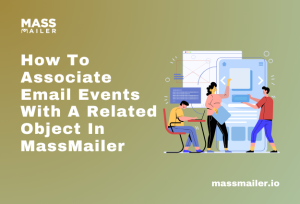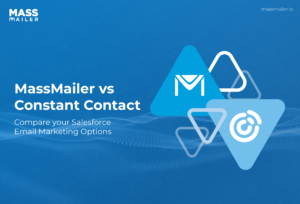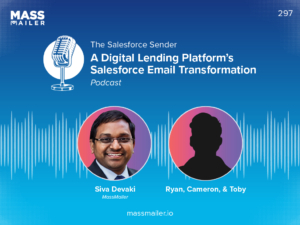Table of Contents
Introduction
Have you ever sent an important email from Salesforce and wondered if the recipient opened it or clicked a link? Most sales and marketing professionals face that same question every day. That’s where Salesforce email tracking becomes essential. It helps you see exactly how people engage with your messages so you can follow up at the right time with the right information.
With tracking in place, you can learn who opened your email, which links caught their attention, and even identify the best time to reach out. According to Gartner’s Digital IQ for Email Marketing Benchmarks, 44 percent of CMOs say email marketing is essential to their strategy.
This guide explains how Salesforce email tracking works, how to set it up correctly, and how to make sense of the results. You’ll also learn how MassMailer enhances Salesforce’s tracking features with advanced analytics, campaign-level visibility, and automation tools that save time.
By the end, you’ll know how to measure every open, click, and reply directly inside Salesforce, and use that data to create more meaningful connections with your customers.
What is Salesforce email tracking?
Salesforce email tracking shows when recipients open your emails, click links, or engage with your messages. It adds a small invisible tracking pixel to each email sent from Salesforce and records activity like opens and clicks in the Activity Timeline.
This feature works through Salesforce’s Enhanced Email functionality, which stores every sent email as a record. When the recipient opens or interacts with the message, the system logs that engagement and updates the related Contact or Lead automatically.
This helps teams understand how customers respond and when to follow up. For example, a sales rep can see if a lead opened an email or clicked a demo link, helping them prioritize next steps or personalize future messages.
Key features of Salesforce email tracking
Salesforce email tracking helps you understand how recipients interact with your messages. It turns every email into measurable data that can guide your next move. Here are some key features that make it useful for sales and marketing teams:
- Open tracking: Records when a recipient opens your email using a small, invisible pixel embedded in the message. This helps you measure how engaging your subject lines and timing are.
- Click tracking: Logs when someone clicks a link in your email. You can see which links attract attention and identify what content drives action.
- Activity Timeline visibility: All tracked interactions appear in the contact or lead’s Activity Timeline, giving you a full view of communication history.
- Enhanced Email storage: Each sent message is stored as a Salesforce record, allowing you to view delivery details, replies, and engagement metrics directly in the CRM.
- Integration with reporting tools: Salesforce tracking data can connect with dashboards or apps like MassMailer to visualize open and click trends over time.
Another helpful feature is that Salesforce can automatically sync tracked email data with custom reports and dashboards. This lets teams monitor engagement metrics in real time without switching tools or exporting data manually.
These features help you move from guessing to knowing, using real engagement data to shape your outreach and improve follow-up timing.
Limitations of native Salesforce email tracking in mass email campaigns
Salesforce email tracking is powerful for one-to-one communication, but it has several limits when you try to scale it for mass email campaigns. Understanding these constraints helps you decide when to use built-in tools and when to look for add-ons like MassMailer that expand your tracking capabilities.
Here are the main limitations you should know:
- Limited mass email capacity: Salesforce restricts the number of emails you can send per day. This makes it challenging to run high-volume campaigns or reach large prospect lists.
- No click or open tracking for all templates: Native Salesforce email tracking doesn’t work for every email template or automation type. For example, some mass email sends through campaign objects don’t record opens or clicks consistently.
- Basic reporting: The built-in reports offer limited insights. You can view opens and clicks, but you can’t easily compare performance across campaigns, time periods, or audiences without custom report building.
- No engagement scoring: Salesforce doesn’t provide engagement scores or trend analysis by default. You can see activity, but not which contacts are most engaged over time.
- Manual data exports: If you need advanced analytics, you often have to export tracking data to spreadsheets or integrate third-party tools, which adds extra steps.
These gaps don’t mean Salesforce tracking isn’t useful. It’s reliable for tracking individual email performance, but it lacks the depth, automation, and analytics most teams need for consistent campaign optimization.
If you’re managing large-scale outreach or want detailed insights into open, click, and bounce metrics, using a Salesforce-native app like MassMailer can help you track emails more accurately and automate reporting without leaving the CRM.
How to set up Salesforce email tracking
Setting up Salesforce email tracking is easier than most people think. Once configured, it lets you see exactly when someone opens your message, clicks a link, or replies, all within your CRM.
Below are the three essential steps to start tracking emails effectively in Salesforce.
Enable Enhanced Email and Email Tracking in Setup
To track emails, you first need to enable Salesforce’s built-in tracking features.
Steps to enable tracking:
- Log in to Salesforce and open Setup.
- In the Quick Find box, type Enhanced Email.
- Turn on Enable Enhanced Email. This feature stores each sent email as a record in Salesforce.
- Next, search for Email Tracking in Setup.
- Turn on Track Email Opens and Clicks.
Once enabled, Salesforce automatically embeds a small, invisible tracking pixel in your outgoing messages. When recipients open or click your emails, that data syncs to their records in real time.
This setup gives your sales or marketing team instant insight into who engages with your outreach and when.
Send and monitor tracked emails in Salesforce for leads and contacts
After enabling tracking, you can start sending emails directly from a lead, contact, or opportunity record.
To send a tracked email:
- Open the record you want to contact.
- Click Email under the Activity panel.
- Write your message and send it.
Salesforce will automatically track opens and clicks. You’ll see this information appear once the recipient interacts with your email.
This process helps you identify warm leads and follow up at the right time instead of guessing who’s interested.
If your team sends large-scale campaigns, MassMailer can extend this capability. It lets you send thousands of tracked emails, view campaign-level performance, and access detailed engagement analytics, all without leaving Salesforce.
View email tracking activity in Salesforce Activity Timeline and EmailMessage object
Every tracked interaction is stored inside Salesforce. You can find these details in two key places:
- Activity Timeline: Displays opens, clicks, and replies alongside other interactions, such as calls or meetings. This gives a complete view of each contact’s engagement history.
- EmailMessage object: Stores technical details like message ID, sender, recipient, timestamps, and engagement status. Admins and advanced users can use this data to build reports and dashboards that track performance over time.
You can also create custom Salesforce reports using this tracking data to measure open rates, click rates, and email engagement trends.
For example, many teams use MassMailer dashboards to visualize opens, clicks, bounces, and unsubscribes across campaigns, helping them see what content resonates and where improvements are needed.
How to track email activity across campaigns and mass sends
Once email tracking is enabled, Salesforce automatically logs every open, click, and reply. The real advantage lies in turning that data into actionable insights that reveal how well your emails and campaigns perform.
Here’s how to track and analyze email activity across Salesforce campaigns and large-scale sends.
Track one-to-one emails in Salesforce
Salesforce automatically tracks every one-to-one email you send from a lead, contact, or opportunity record.
- Salesforce records whether the recipient opened your email, so you can confirm if your message reached them.
- It logs the exact time and date of each open, which helps you identify the most effective sending times.
- It tracks which links the recipient clicked, giving you insight into what content captures their interest.
This data appears in the Activity Timeline, showing each interaction in context with other touchpoints. If a lead has opened several emails or clicked multiple links, it signals genuine interest, a perfect cue for timely follow-up.
Track campaign or list emails in Salesforce
When you send emails using Salesforce Campaigns, tracking works differently from individual emails. The native functionality captures basic data, such as delivery results and unsubscribes, but it doesn’t always show detailed open or click metrics for every campaign.
To get a fuller picture of campaign engagement:
- You can use the EmailMessage object to monitor delivery, bounce, and read-status details for each recipient.
- You can create custom report types that compare open and click rates across campaigns.
- You can merge Campaign Member reports with Contact and Lead reports to identify which audiences are most responsive.
These steps help you track performance across mass sends, identify trends, and understand which campaigns deliver the strongest engagement inside Salesforce.
Use MassMailer for bulk sends in Salesforce
If you send a high volume of emails, MassMailer helps you track performance beyond what Salesforce’s native tools can measure. It integrates directly with Salesforce, adds advanced analytics, and simplifies reporting for larger teams.
With MassMailer, you can:
- Send and track thousands of emails in a single campaign without hitting Salesforce’s daily send limits.
- Measure unique opens, clicks, bounces, unsubscribes, and spam reports with real-time accuracy.
- Filter reports by campaign, sender, or recipient segment to find your highest-performing audiences.
- View visual dashboards that show open and click trends over time to identify which messages work best.
- Automate scheduled reports so your team can track progress without manual effort.
This level of tracking gives your team a clear view of how every campaign performs, helping you focus on strategies that increase engagement and drive results.
How to optimize Salesforce email automation for better engagement
Automating emails in Salesforce saves time, but true performance comes from improving how people interact with those emails. When you focus on the right engagement metrics: open rate, click-through rate, conversion rate, and bounce rate, then automation becomes a system that consistently drives better results.
Here’s how to optimize each area effectively.
Improve open rate
Open rates tell you whether your subject lines and timing are connecting with your audience. To improve this metric in Salesforce:
- You can personalize subject lines using merge fields such as the recipient’s first name or company to make emails feel more direct.
- You can send emails from a verified and recognizable sender name so recipients trust the message source.
- You can test different sending times by reviewing Salesforce email engagement data to identify when most users open emails.
- You can write clear, value-driven subject lines that promise specific benefits, such as “Track your Salesforce emails in real time.”
- You can monitor open-rate trends in Salesforce reports or MassMailer dashboards and adjust based on results.
According to HubSpot, emails with personalized subject lines are more than 20 percent more likely to get opened.
Increase click-through rate
Click-through rate (CTR) shows how well your content encourages readers to take action. To increase CTR in Salesforce email automation:
- You can include a single, clear call to action (CTA) that tells the recipient exactly what to do next.
- You can position your CTA near the top of the email so it’s visible without scrolling.
- You can use descriptive, action-oriented CTA text such as “View report” or “Schedule demo.”
- You can track link clicks in Salesforce or MassMailer analytics to identify which content attracts the most attention.
- You can experiment with visuals and link placement to learn what layout drives higher engagement.
Improving CTR helps your automation do more than send; it drives readers toward meaningful next steps.
Boost conversion rate
A conversion happens when your reader takes the final action you intended, like booking a call or submitting a form. To boost conversions using Salesforce automation:
- You can ensure the landing page linked in your email matches the message and intent of the content.
- You can reduce friction by keeping forms short and removing unnecessary steps.
- You can test different offers or CTAs within your automated journeys to see what converts best.
- You can measure conversion paths using Salesforce Campaign reports to identify where users drop off.
- You can use MassMailer reporting to link email engagement with actual sales conversions inside Salesforce.
Optimizing for conversions means connecting your automation directly to measurable business outcomes.
Reduce bounce rate
A high bounce rate affects deliverability and sender reputation. To minimize bounces in Salesforce:
- You can verify email addresses before sending using Salesforce validation tools or MassMailer EmailVerifier. Watch this video, which gives you a detailed walkthrough of verifying email lists on Salesforce.
- You can clean your database regularly to remove invalid, duplicate, or inactive contacts.
- You can segment new leads separately until they confirm engagement to prevent hard bounces.
- You can monitor bounce patterns in Salesforce reports and adjust sending frequency or audience lists.
- You can use clear opt-in processes to ensure recipients genuinely want your messages.
A lower bounce rate improves sender credibility, helping your emails reach inboxes more reliably.
Build Salesforce dashboards and reports for email tracking
Tracking opens and clicks is just the start. To make email tracking truly valuable, you need dashboards and reports that show trends, performance, and opportunities for improvement. Salesforce allows you to visualize data in real time, helping you and your team make informed, data-driven decisions.
Here’s how to build effective dashboards and reports that enhance your email tracking results.
Essential email tracking metrics
The right metrics help you understand how your audience interacts with your emails, not just whether they received them.
- You can track open rate to measure how many recipients view your emails and to test subject line performance.
- You can measure click-through rate (CTR) to learn which CTAs and links generate the most engagement.
- You can monitor bounce rate to identify list quality or deliverability issues early.
- You can calculate the conversion rate to connect email interactions with tangible outcomes like sign-ups or purchases.
- You can track the unsubscribe rate to understand when your content or frequency needs adjustment.
These key metrics provide a clear view of how your Salesforce email campaigns perform and where to focus your optimization efforts.
Create dashboards for visibility and performance
Dashboards make tracking data easy to interpret and share across teams.
- You can build custom report types that combine EmailMessage records with Contact or Campaign data for deeper analysis.
- You can design visual charts that show open, click, and bounce trends over time.
- You can apply filters to compare performance by campaign type, sender, or audience segment.
- You can schedule automated dashboard refreshes so your data stays up to date.
- You can share dashboards with marketing and sales teams to align on outreach strategies and engagement results.
A well-designed dashboard helps everyone stay focused on what drives engagement and conversions.
Use MassMailer for real-time reporting
While Salesforce provides valuable data, MassMailer extends it with advanced tracking and reporting capabilities designed for scale.
- You can track detailed metrics like total opens, unique clicks, bounces, unsubscribes, and spam reports in real time.
- You can view campaign-level dashboards that automatically summarize performance.
- You can automate report delivery to your inbox or Slack channel for quick visibility.
- You can compare multiple campaigns in one dashboard to identify the best-performing strategies.
- You can filter by sender, region, or time frame to uncover specific engagement trends.
MassMailer’s reporting suite turns Salesforce tracking into a proactive system for analyzing and improving every email you send.
Best practices for Salesforce email tracking
Once your email tracking is set up in Salesforce, keeping it reliable comes down to consistency. Clean data, compliance, and deliverability all work together to make your reports accurate and meaningful. These best practices help you maintain dependable tracking, avoid errors, and build stronger engagement over time.
Maintain clean data and associations
Clean CRM data is the foundation of accurate Salesforce email tracking. When your contact and lead records are complete and correctly linked, every open, click, and unsubscribe syncs to the right person.
- Verify email addresses regularly using Salesforce Duplicate Management or MassMailer Email Verifier.
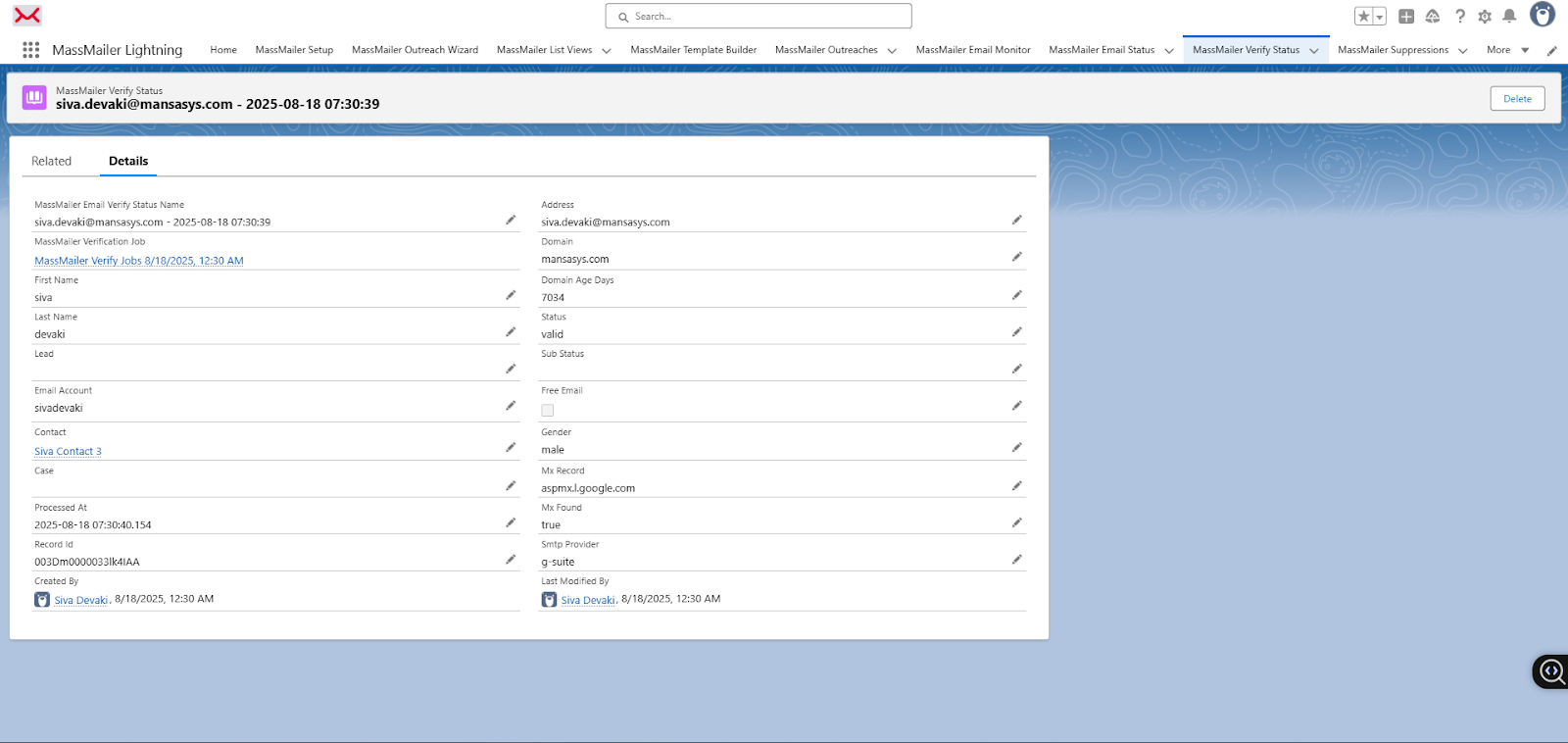
- Archive inactive or invalid contacts to prevent reporting noise.
- Keep your contact, lead, and campaign associations consistent for accurate tracking and attribution.
- Sync key engagement fields between Salesforce and MassMailer to ensure real-time accuracy.
Clean data ensures your open and click metrics reflect real engagement, not duplicate or outdated information.
Avoid false opens and tracking errors
Not every “open” means a person actually read your email. Some email clients and security filters trigger tracking pixels automatically. To keep your numbers real:
- Focus on unique opens and clicks in Salesforce reports to remove duplicate counts.
- Exclude internal test domains from reports to avoid inflating engagement metrics.
- Compare email engagement with response actions like replies or conversions for context.
- Use MassMailer’s tracking filters to separate genuine user actions from automated security scans.
Accurate tracking helps you make smarter campaign decisions without overestimating engagement.
Respect privacy and compliance rules
Respecting privacy builds trust and keeps your organization compliant with global email regulations. Salesforce gives you the tools to track responsibly.
- Store consent preferences and opt-out details in dedicated Salesforce fields.
- Include unsubscribe links in every email to comply with GDPR and CAN-SPAM requirements.
- Honor opt-out requests immediately to protect the sender’s reputation and avoid penalties.
- Anonymize or delete inactive data according to your company’s retention policy.
- Review Salesforce Shield or MassMailer’s compliance settings to strengthen data protection.
Compliance isn’t just a box to check; it’s part of building long-term credibility with your audience.
Improve deliverability and system performance
High deliverability ensures your tracked emails reach inboxes, not spam folders. Performance tuning keeps your automation reliable.
- Authenticate your sending domain using SPF, DKIM, and DMARC for better trust scores.
- Warm up new email domains gradually to establish sender reputation.
- Keep templates lightweight with minimal images and optimized HTML.
- Limit large attachments that slow delivery and increase bounce risk.
- Monitor delivery trends in Salesforce and MassMailer dashboards to detect deliverability drops early.
Good deliverability keeps your campaigns consistent and your tracking insights dependable.
Choose the right Salesforce email tracking tool for your business needs
Not every Salesforce team needs the same level of tracking. Some only want to know if a prospect opened an email. Others need a detailed view of who clicked, when, and how engagement leads to conversions. Choosing the right Salesforce email tracking tool depends on how deep you want your insights to go.
Let’s compare when Salesforce’s native tracking is enough, and when it’s worth using a purpose-built solution like MassMailer.
When native tracking is enough
Salesforce includes built-in tracking features that work well for smaller teams or individual reps managing direct communication.
- Native tracking automatically records when an email is sent, opened, or replied to, and links this activity to the related contact or lead record.
- It displays engagement activity in the Activity Timeline, helping sales reps follow up at the right time.
- It supports simple, manual outreach, which is ideal for low-volume, relationship-based selling.
- It integrates with Enhanced Email, letting you view engagement data without custom setup.
- It performs best when you only need visibility into one-on-one or low-frequency communications.
Native tracking is a reliable choice when you value simplicity and only need to monitor basic engagement metrics inside Salesforce.
When to use MassMailer for advanced tracking
As your campaigns scale, Salesforce’s standard tracking may not capture the depth or automation you need. That’s where MassMailer adds measurable value.
- MassMailer tracks detailed engagement metrics such as total and unique opens, clicks, bounces, unsubscribes, and spam reports in real time.
- It supports mass email campaigns, automations, and drip sequences directly inside Salesforce without external connectors.
- It provides deliverability insights, helping you monitor sender reputation and bounce trends.
- It includes A/B testing tools for subject lines, templates, and send times to improve open and click rates.
- It unifies engagement data across Contacts, Leads, and Campaigns, offering a complete reporting view within Salesforce.
For teams focused on performance analytics, compliance, or scaling outreach, MassMailer extends Salesforce’s capabilities into a full reporting and optimization platform.
Checklist for evaluating tracking solutions
Before selecting your email tracking setup, assess your needs using this quick checklist:
- Engagement visibility: Does the tool track clicks, opens, and bounces in real time?
- Scalability: Can it handle bulk sends or automated workflows without throttling?
- Integration depth: Does it sync seamlessly with Salesforce Campaigns and reporting dashboards?
- Compliance: Does it meet privacy, consent, and data protection requirements?
- Analytics and insights: Does it connect engagement metrics to business outcomes like conversions or revenue?
If you only need to confirm that emails were opened, Salesforce’s built-in tracking works fine.
If you need full visibility across campaigns and advanced analytics, MassMailer offers a more complete, scalable solution.
Conclusion
Email tracking in Salesforce is all about understanding engagement and using that insight to build better relationships. Whether you rely on Salesforce’s native tracking or use a dedicated tool like MassMailer, the goal is the same: deliver messages that reach the right people and drive measurable action.
MassMailer makes this process easier and more powerful. It brings advanced tracking, real-time reporting, and automation directly inside Salesforce, helping your team focus on performance instead of manual data checks.
If you want to move beyond basic email visibility and start tracking what truly drives engagement, try MassMailer for Salesforce today. You’ll gain the clarity, scalability, and data accuracy needed to send smarter, not just more emails.
Start your free MassMailer trial today or book a live demo to see how easily you can track, analyse, and optimise your Salesforce email campaigns in real time.
Frequently Asked Questions
1. How accurate is Salesforce email tracking?
Salesforce email tracking is accurate for basic engagement data like opens and replies, but it doesn’t capture advanced metrics such as unique clicks or deliverability rates. For complete accuracy, teams often use tools like MassMailer that log real-time opens, clicks, bounces, and spam reports directly in Salesforce.
2. Can Salesforce track email clicks and link activity?
Salesforce’s native tracking records opens and responses, but doesn’t track link-level clicks in emails. To track clicks, you can integrate MassMailer, which provides full link-tracking visibility across leads, contacts, and campaigns within Salesforce dashboards.
3. What’s the difference between Enhanced Email and MassMailer tracking in Salesforce?
Enhanced Email records basic send and open events. MassMailer expands that functionality by tracking unique clicks, unsubscribes, bounces, and spam reports in real time, offering complete performance analytics inside Salesforce.
4. How do I improve Salesforce email deliverability?
You can improve deliverability by authenticating your domain with SPF, DKIM, and DMARC records, cleaning your contact list regularly, and avoiding spam-trigger words in your templates. MassMailer helps monitor deliverability rates and bounce patterns directly within Salesforce reports.
5. Does Salesforce email tracking work with Gmail or Outlook?
Yes. When integrated through Salesforce Inbox or compatible apps, email tracking works with Gmail and Outlook. However, these integrations mainly track opens and replies. MassMailer extends this capability to include clicks, unsubscribes, and detailed campaign performance inside Salesforce.
6. Is MassMailer compliant with GDPR and CAN-SPAM for Salesforce email tracking?
Yes. MassMailer is designed with compliance in mind. It includes unsubscribe management, consent tracking, and automated suppression lists to help Salesforce users meet GDPR and CAN-SPAM standards without extra setup.
Start Your Free Trial Today
Experience MassMailer the easiest way to send personalized emails from Salesforce.
Related Blogs
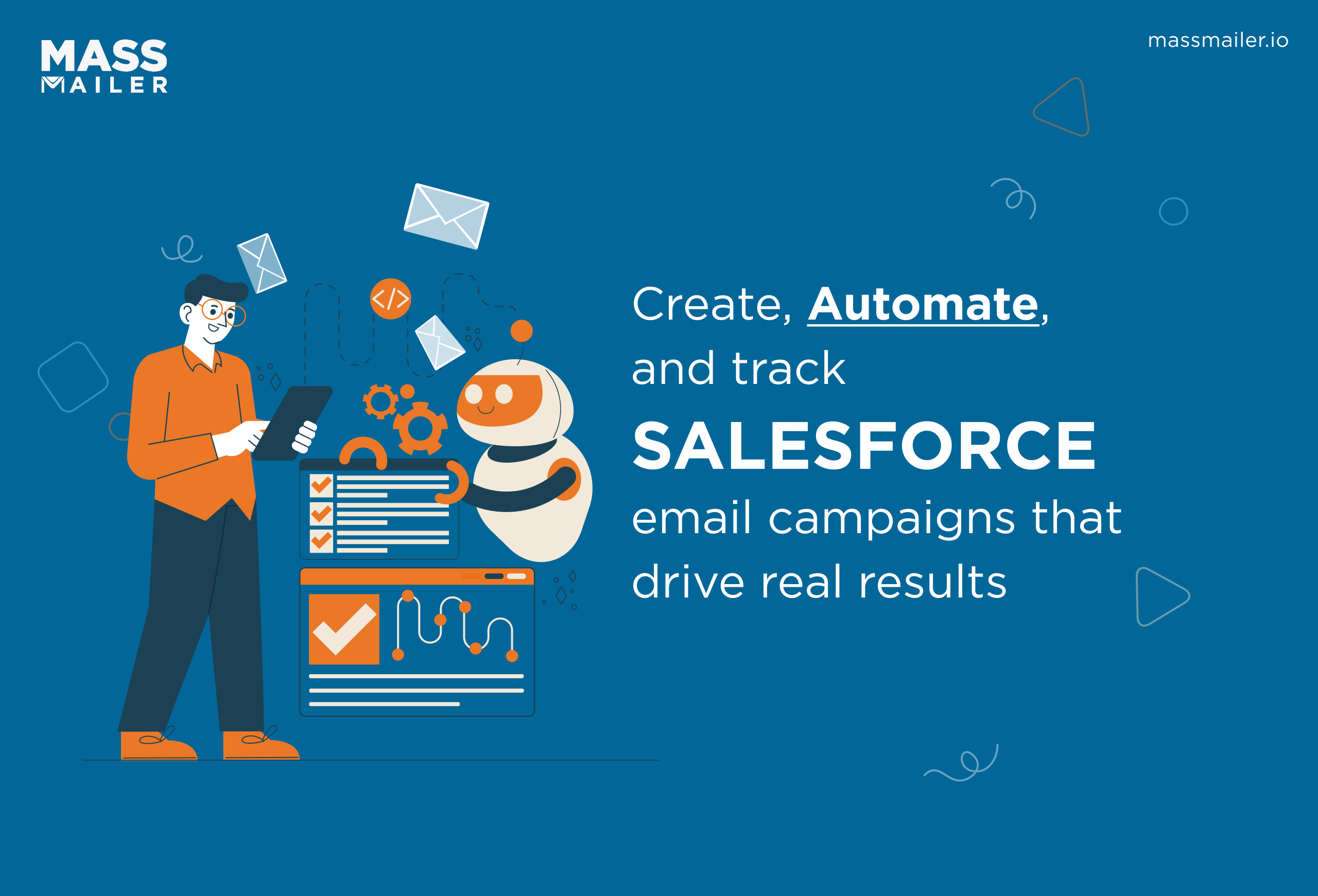
How to Create and Optimize Salesforce Email Campaigns with MassMailer
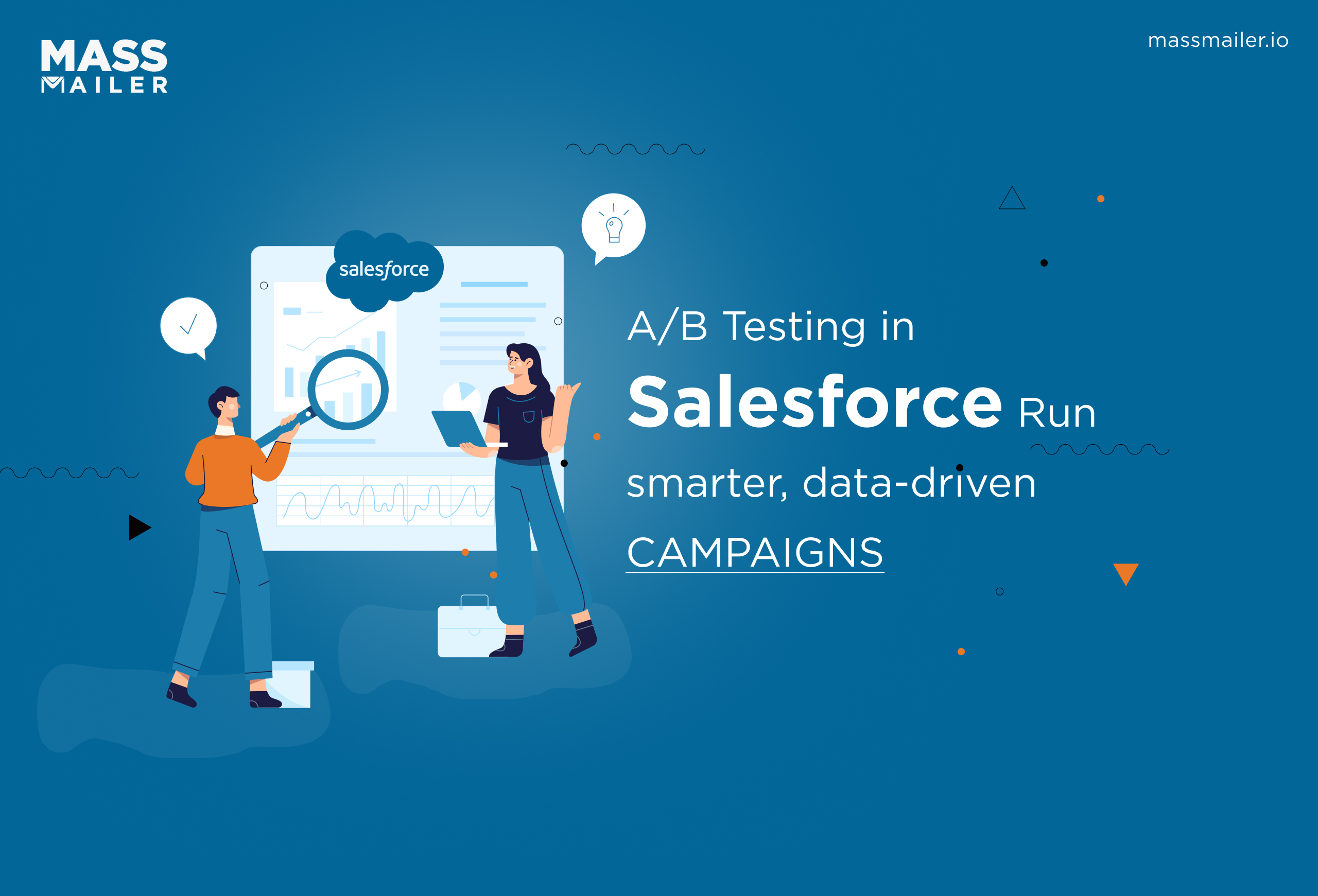
A/B Testing in Salesforce: A Step-by-Step Guide to Boost Email Campaigns
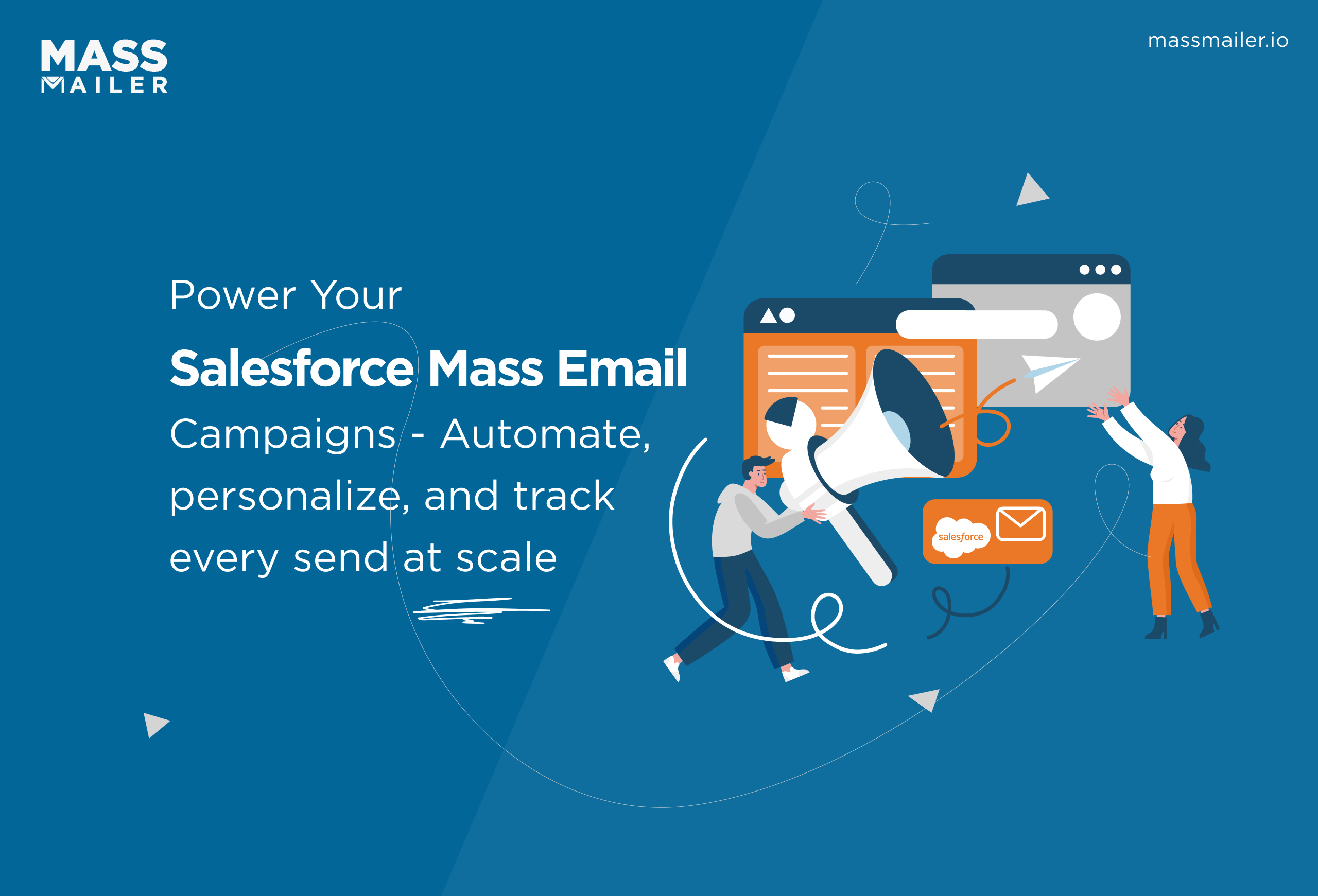
Mastering Salesforce Mass Email Campaigns: Best Practices & Tools
MassMailer Resources



